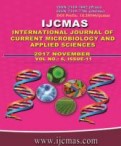


 National Academy of Agricultural Sciences (NAAS)
National Academy of Agricultural Sciences (NAAS)

|
PRINT ISSN : 2319-7692
Online ISSN : 2319-7706 Issues : 12 per year Publisher : Excellent Publishers Email : editorijcmas@gmail.com / submit@ijcmas.com Editor-in-chief: Dr.M.Prakash Index Copernicus ICV 2018: 95.39 NAAS RATING 2020: 5.38 |
Pulses are the second most important group of crops grown worldwide. Among pulses, black gram (Vigna mungo L. Hepper) occupies a prominent place in India. Black gram grain contains about 24% protein, 60% carbohydrates, 1.3% fat with desirable amount of minerals like calcium, phosphorus, iron and certain vitamins. Yellow mosaic virus is one of the most important constraints for blackgram production. To identify genetic sources of resistance to yellow mosaic virus (YMV) in blackgram, the genetic variability is lost and it is this genetic potential for high yield needs to be regenerated. Four parents viz., Vamban 4, Vamban 2, LBG 17 and CO 5 and their 12 hybrids, obtained through full diallel mating design were evaluated for important quantitative traits during Rabi, 2010-2011 for YMV and improvement of yield. Genetic variability, the PCV value was found higher in all the characters studied except days to 50 percent flowering, days to maturity and number of seeds per pod than the GCV. Based on per se performance, gca effects and sca effects, CO 5 x VBN 2 cross combination was found to be superior which combine yield and quality characters and these hybrid can be utilized for recombination breeding. Based on per se performance, sca effects and standard heterosis, two cross combinations viz., LBG 17 x CO 5 and VBN 2 x LBG 17 was found to be superior which combine yield and quality characters and these hybrids can be utilized for heterosis breeding. Investigation on the magnitude of heterosis helps to identify promising hybrid combination and also possible to exploit to new recombinant type for yield and attributing traits from segregants.
 |
 |
 |
 |
 |